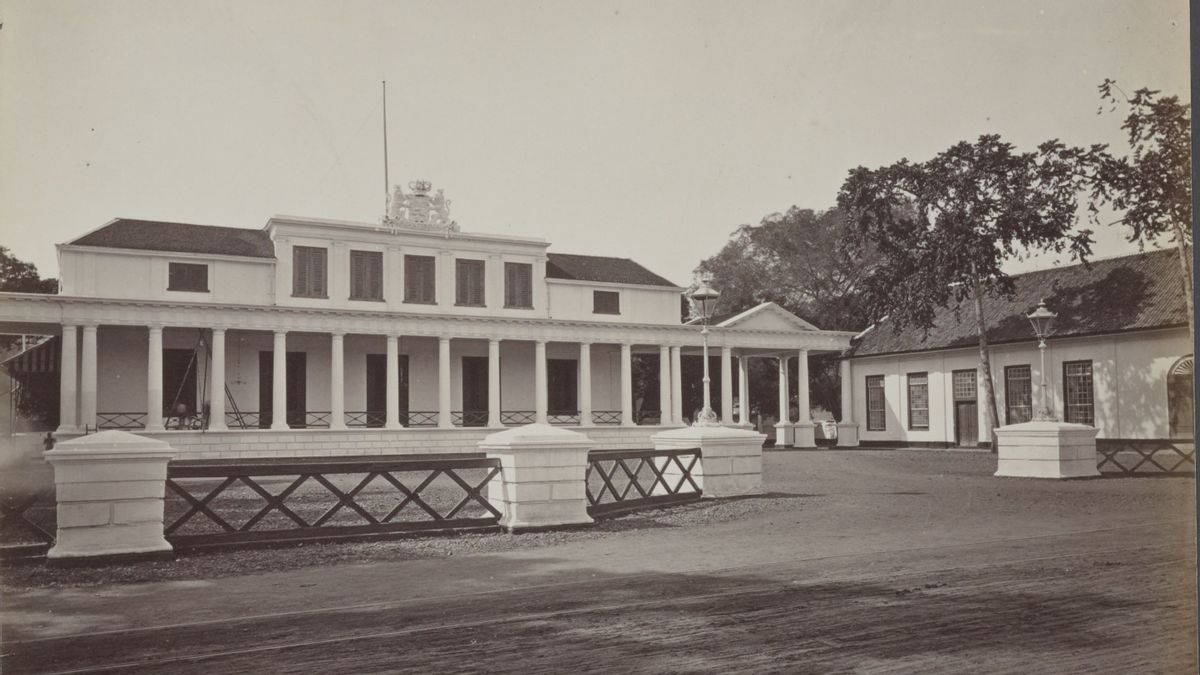JAKARTA - If there is a building that holds so much history regarding the progress of the nation's leaders, the State Palace is definitely one of them. When it was first built, the dominant white building was used as a stopover for the governors-general of the Dutch East Indies. The people dubbed the State Palace as Paleis Rijswijk or Rijswijk Palace.
Based on various literacies, this large building on Jalan Merdeka Utara, Central Jakarta is the residence of a wealthy Dutchman, Jacob Andries van Braam. In 1796, Jacob, a former Dutch resident of Surakarta, founded a two-story retreat in the style of closed classism.
At that time, the building erected by Jacob was the only magnificent building that stood out in the most prestigious area in Batavia. Quoted by Agus Dermawan T. in the book Dari Lorong-Lorong Presidential Palace (2019), the building provoked a lot of admiration and praise.
In fact, a classmate of Governor General Thomas Stamford Raffles, who began to invade the Dutch East Indies in 1811-1816, also expressed admiration for Paleis Rijswijk. When in power, Raffles confiscated all buildings belonging to VOC officials who were close to the previous Dutch East Indies governor-general in the Weltevreden area (Nieuw Batavia), except for Jacob's luxury villa.

"When the British came to power in Indonesia, Thomas Stamford Raffles organized along the road in front of Jacob's house. Jacob's classy house - also the family residence of WH van Iiseldijk, the Royal Director General for Land and Finance Affairs - was taken over and looked after. When in Raffies' hands, Jacob's house, which the Dutch still dubbed the Paleis Rijswijk or Rijswijk Palace, served as a Rijswijk landmark, ”he wrote.
Meanwhile, only one house, namely Iiseldijk's house, was acquired by Raffles and then beautified. The house was later nicknamed "Raffles House", after which functioned as Hotel Der Nederlanden. However, Raffles actually spent more time at Paleis Rijswijk than at Raffles House. Raffles said, Jacob as the host was a reliable person in entertaining guests.
Raffles still feels that luxury, making him feel at home in Paleis Rijswijk. As stated in the book The Presidential Palace of Indonesia (1975), after the Raffles era, Paleis Rijswijk became a favorite place for the governors-generals of the Dutch East Indies to hold important meetings. For this reason Paleis Rijswijk got the nickname Hotel van den Gouverneur-Generaal or the hotel of the governors-general.
“In the early 19th century and during the 20th century, governors-general generally lived in the mild climate of Bogor. However, sometimes they had to go to Batavia, especially for the meeting of the Council of the Indies, which in the 19th century met at the State Palace (Paleis Rijswijk) every Wednesday, "said Adolf Heuken Sj in the book Historical Places in Jakarta ( 2007).
Become the governor general's officeAfter long holding the title of hotel governor-general, Paleis Rijswijk changed its function to become the center of government during the time of Governor General Godert Alexander Gerard Philip baron van der Capellen (1816-1826). Due to his negotiating skills, the number one man in the Indies was able to convince Jacob to make his temporary residence an office through a rental system.
Later, Capellen also managed to convince Jacob to sell his house. Officially, Paleis Rijswijk became the office of the Dutch East Indies colonial government in 1821. At that time, large meetings surrounding the resistance against Prince Diponegoro to the Sultan of Palembang were often held in Paleis Rijswijk.

It was only in 1826 that King Willem I, who knew that the building at the center of the Dutch government in the Indies looked congested, instructed him to build a twin. However, the additional building has never been made. The reason is because most of the funds have been absorbed to finance Dutch troops in a series of wars in the archipelago.
“The state palace (Paleis rijswijk) is not a very artistic building but is elegant. In the beginning the building did not have a wide and open foyer like many Indisch Woonhuizer (indis-style houses). The porch that was added later is slightly circular with stairs on the left and right. From the veranda, people can enter the palace through five wide doors and all of them face Jalan Veteran, ”said an important figure in the writing of Jakarta history, Adolf Heuken.
When Indonesia became independentWhen Indonesia became independent, Paleis Rijswijk changed its name to the State Palace. Which, by the owner of the government, this building is protected by the Cultural Heritage Law. Every renovation is carried out while maintaining the original face of the building.
"The front porch with sturdy and sturdy pillars which are characteristic of colonial buildings, still looks like when this building was first built," added Kukuh Pamuji in the book Menyelisik Museum Presidential Palace Jakarta (2020).
Various historical events for the Indonesian nation took place at the State Palace. Some of them, on March 25, 1947, the State Palace was once used as the place for the signing of the Linggarjati Agreement text, in which Indonesia was represented by Sutan Sjahrir and the Netherlands was represented by Dr. Van Mook.
Not only that, the recognition of Indonesian Independence was also signed here at the end of 1949. The Indonesian representative at that time was Sultan Hamengkubuwono IX. Meanwhile, the Netherlands was represented by AHJ Lovink. The signing ended the war of independence from 1945 to 1949. After that, until now the State Palace serves as the center of state government activities.
"Among them is being a place for holding state events, such as the inauguration of high state officials, the opening of national meetings and work meetings, the opening of national and international congresses, and state banquets," concluded Kukuh Pamuji.
The English, Chinese, Japanese, Arabic, and French versions are automatically generated by the AI. So there may still be inaccuracies in translating, please always see Indonesian as our main language. (system supported by DigitalSiber.id)










